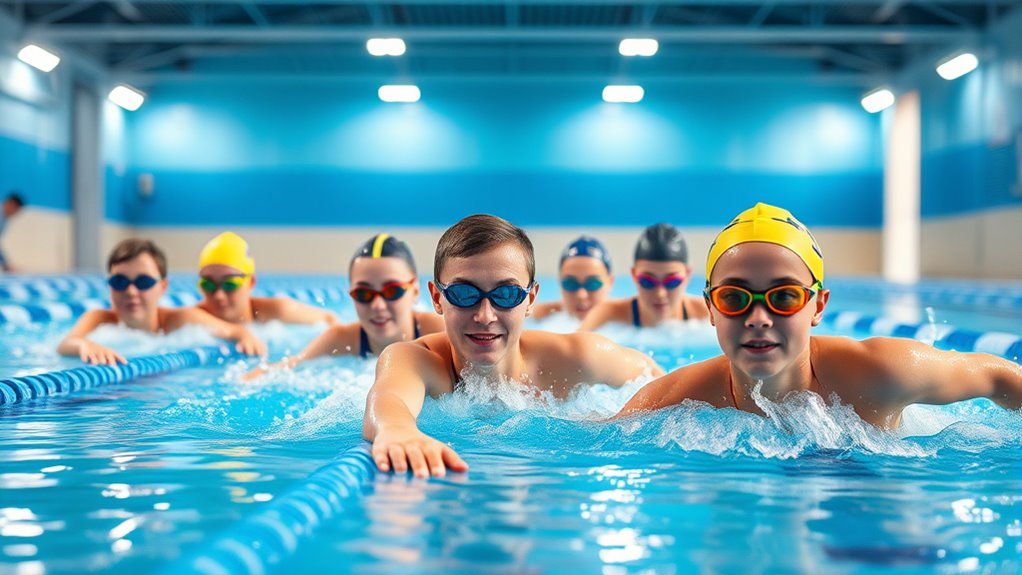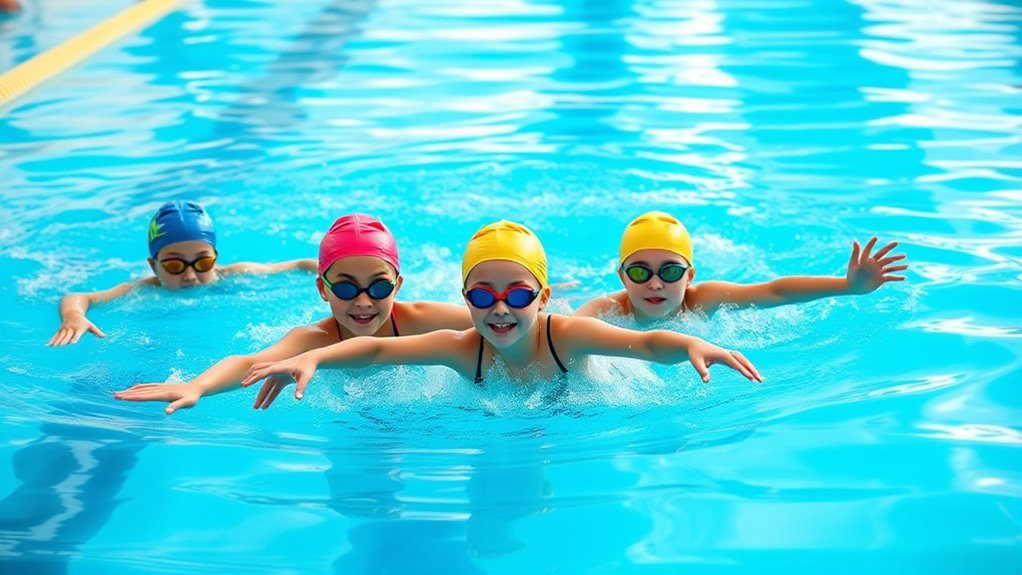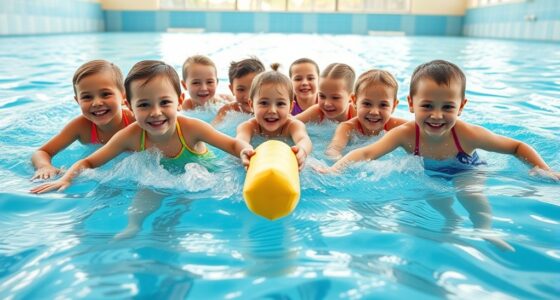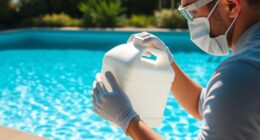To improve as a new swimmer, focus on basic lap drills like the catch-up to develop smooth arm movements and streamline your body. Practice rhythmic breathing to stay relaxed and conserve energy, and use drills with fins or paddles to strengthen technique. Gradually increase your distance and reduce rest to build endurance. Consistent practice with controlled, efficient strokes will boost your confidence and stamina—keep moving forward, and you’ll discover more ways to enhance your skills.
Key Takeaways
- Practice breathing drills focusing on rhythmic inhalation and exhalation to establish consistent breathing patterns.
- Use streamlined body position drills to reduce drag and improve efficiency during laps.
- Incorporate catch-up and pull buoy drills to enhance arm movement control and glide.
- Gradually increase lap counts and reduce rest periods to build endurance steadily.
- Maintain proper form and technique with drills that promote body alignment and controlled strokes.

Are you looking to improve your swimming technique and boost your endurance? If so, focusing on specific lap swimming drills can make a significant difference. One of the most effective ways to enhance your overall performance is by honing your breathing techniques. Proper breathing helps you stay relaxed in the water, prevents fatigue, and allows for better oxygen intake during your swim. To start, practice rhythmic breathing—inhale deeply through your mouth or nose as you turn your head to the side, then exhale steadily underwater. This approach ensures a steady airflow, reducing the chances of gasping or holding your breath, which can disrupt your stroke. By consciously working on your breathing, you’ll find it easier to maintain a consistent rhythm and conserve energy throughout your laps.
In addition to breathing techniques, focusing on stroke efficiency is essential. Many new swimmers tend to waste energy with inefficient movements, which quickly drains their stamina. To improve, incorporate drills that emphasize streamlined body position and smooth, controlled arm movements. For example, try swimming with a pull buoy to isolate your arm strokes and focus on pulling through the water with minimal splashing. This allows you to feel how your arm should move and how your body should stay aligned. Another effective drill is the catch-up drill, where you stretch out each arm fully before starting the next stroke, encouraging a longer, more efficient glide and reducing unnecessary movements. These drills train you to use your energy more effectively, making every stroke count.
Building your endurance also involves gradually increasing your distance and intensity. As you become more comfortable with your breathing and stroke technique, add sets that challenge your stamina. For example, swim multiple laps at a steady pace, then take short rest intervals to recover. Over time, extend the number of laps and reduce rest periods to push your endurance further. Incorporating proper equipment like fins or paddles can also help improve your technique and strength. Consistency is key—regular practice helps your body adapt and improves your efficiency in the water. Remember to focus on maintaining proper form and breathing patterns even as you increase your workload. This way, you’ll develop a sustainable swimming rhythm that boosts both your endurance and confidence.
Frequently Asked Questions
How Can I Improve My Breathing Technique During Laps?
To improve your breathing technique during laps, focus on establishing a steady breathing rhythm that matches your strokes. Practice exhalation control by fully emptying your lungs underwater, which makes inhaling easier and more efficient. Try rhythmic breathing patterns, like every three strokes, to maintain consistency. Concentrate on smooth, relaxed exhalation and inhalation, and gradually increase your comfort with breath control, helping you swim more efficiently and with less fatigue.
What Are the Best Drills for Increasing My Swimming Endurance?
To boost your swimming endurance, focus on drills that improve breath control and stroke efficiency. Incorporate interval training, like swimming multiple laps at a steady pace with short breaks, to build stamina. Practice bilateral breathing to enhance breath control and maintain a consistent rhythm. Using kick drills and pull sets also strengthen muscles, helping you swim longer without fatigue. These strategies will help you swim more efficiently and increase your endurance over time.
How Do I Avoid Common Beginner Swimming Mistakes?
Think of your swimming journey as a dance—you need harmony to glide smoothly. To avoid common mistakes, focus on maintaining a steady breathing rhythm, so your body stays relaxed and synchronized. Perfect your streamline technique by keeping your body long and straight, slicing through water like a sword. Stay mindful of your form, and don’t rush; patience turns small strokes into fluid, confident movements.
What Equipment Is Essential for New Lap Swimmers?
As a new lap swimmer, essential equipment includes a comfortable swim cap and a kickboard. A swim cap helps reduce drag and keeps your hair out of your face, making your swim more efficient. A kickboard allows you to focus on your kick technique without worrying about arm movements. These items are simple, affordable, and improve your practice, helping you build confidence and improve your overall swimming skills.
How Can I Stay Motivated to Swim Regularly?
To stay motivated to swim regularly, set realistic goals that challenge yet are achievable, like swimming a certain number of laps or minutes each week. Track your progress to see improvements, which boosts your motivation. Remember, consistency is key, so celebrate small successes and remind yourself why you started. Keeping your goals visible and rewarding your efforts will help you stay committed and enjoy your swimming journey.
Conclusion
As you immerse yourself in these lap swimming drills, think of yourself as a skilled artist chiseling away at a masterpiece. With each stroke, you’re painting a picture of confidence and mastery in the water. Remember, progress flows like a gentle current—steady, relentless, and unstoppable. Keep practicing, and soon you’ll glide through the pool with the grace of a swimmer born to conquer the water. Your aquatic journey has just begun, and the depths await your command.










